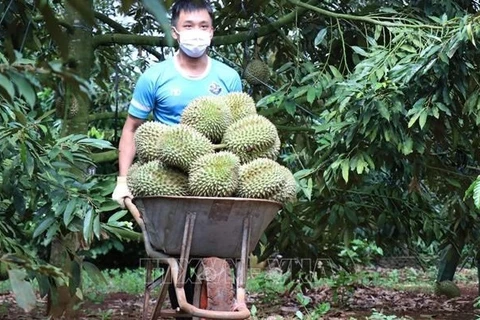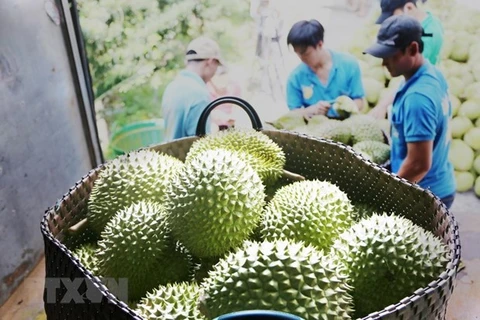Hanoi (VNA) – With advantages in geographical proximity and year-round supply, durians are expected to be a major hard currency earner when the fruit is exported to China through official channels from July 11, 2022.
However, these advantages and opportunities are only capitalised on when the production process ensures food hygiene and meets the Chinese market's requirements.
Ready for export
After four years of negotiations, on July 11, 2022, a protocol on phytosanitary requirements for Vietnamese durians exported to China was signed - an important condition for the fruit to have a sustainable import market.
 China is still the largest importer of Vietnamese durians, but this fruit is mainly exported to China via border gates - Illustrative image (Photo: VNA)
China is still the largest importer of Vietnamese durians, but this fruit is mainly exported to China via border gates - Illustrative image (Photo: VNA) The protocol, signed by Minister of Agriculture and Rural Development Le Minh Hoan, will be sent to the General Administration of Customs of China and published on its portal, together with lists of eligible durian growing areas and packing facilities in Vietnam.
The fruit will be allowed to be exported to China after the protocol is publicised officially.
The protocol stipulates that all growing areas registered for export to China must build quality management and traceability systems, apply Good Agricultural Practices (GAP), and ensure conditions such as being sourced from clean cultivating gardens away from pollution, without fallen or rotten fruits.
In addition, they must apply integrated pest management (IPM) programmes, including pest surveillance, chemical or biological control, and other farming practices.
China is still the largest importer of Vietnamese durians, but this fruit is mainly exported to China via border gates.
Recently, the General Administration of Customs of China agreed on the pilot import of Vietnamese passion fruit.
Vietnam's current durian output is estimated at 1.3 million tonnes. The country now has about 85,000- 90,000 hectares of durian growing for official export, mainly in Tay Ninh, Binh Duong, Dong Nai, Binh Phuoc, Tien Giang and Dak Lak provinces.
Director of the Department for Plant Protection at the Ministry of Agriculture and Rural Development Hoang Trung said there are currently 123 growing area codes and 57 packaging facilities registered to export durians to the Chinese market.
He added that the Department for Plant Protection has already sent phytosanitary certificates, as required by the protocol, to the General Administration of Customs of China to check when shipments arrive in the country.
The Department of Plant Production and the Department of Agriculture and Rural Development of the Central Highlands province of Dak Lak have co-organised a training course to establish durian growing areas and packaging facilities in the Central Highlands serving exports to China.
From July 18 – 20, the course attracted the participation of public personnel, businesses, and farmers involved in the production and export process in the region.
Its training focused on Chinese regulations related to food safety and phytosanitary and guidance on forming orchards and packaging facilities for durian exports to the market.
Meanwhile, the Vietnam Trade Promotion Agency (VIETRADE) and the authorities of Dak Lak, which houses large durian plantations in the Central Highland, will run a hybrid consultation on exporting Vietnamese durians on July 22 to field queries from interested firms.
The event will take place in Dak Lak, allowing participation on Zoom.
In the past decade, Vietnam's durian plantations increased rapidly. From being planted mainly in the Mekong Delta and a few places in the Southeast region, the tree now appears more and more in the Central Highlands.
Improving quality from linkages
Many businesses held that there are more and more opportunities to export durians, creating momentum for improving the product's value.
Ngo Tuong Vy, Deputy Director of Chanh Thu Import-Export Co. Ltd, said Vietnamese durians could compete with similar products from foreign countries. However, she added that domestic farmers and businesses should learn experience from Thailand to enhance the brand of Vietnamese durians.
Minister of Agriculture and Rural Development Le Minh Hoan said the export of durians via the official channels would create room for the sector's growth and increase incomes for thousands of farmers, especially those in the Central Highlands, Southeastern region and Mekong Delta./.

























